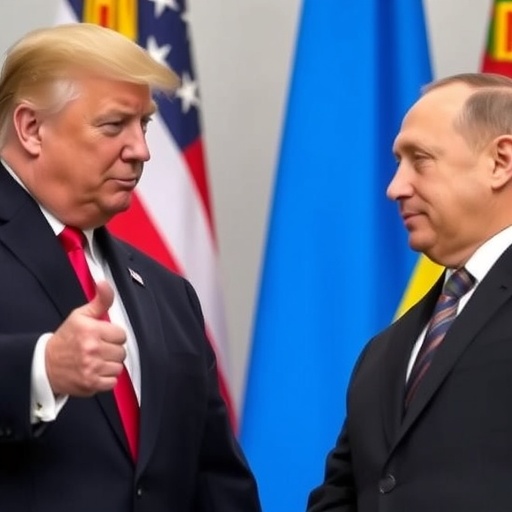Trump Urges China to Join US in Brokering Russia-Ukraine Peace Deal Amid Escalating Tensions
In a stunning diplomatic pivot, President Donald Trump has publicly called on China to partner with the United States in mediating peace talks with Russia to resolve the protracted Ukraine war, signaling a potential thaw in US-China relations amid global instability. Speaking from the White House Rose Garden on Monday, Trump emphasized the urgency of involving Beijing in negotiations, stating, “China has the influence with Russia that we need right now. It’s time for all hands on deck to end this senseless conflict.” This announcement comes as Trump prepares for a high-stakes Asia tour, including a pivotal summit with Chinese President Xi Jinping in Beijing later this week.
- Trump’s Strategic Outreach: Why China Holds the Key to Russia Talks
- Xi Jinping’s Dilemma: Balancing Ties with Russia and US Diplomacy
- Global Reactions: Allies and Adversaries Weigh Trump’s China Gambit
- Trump’s Asia Tour: From Tokyo to Beijing, Mapping the Diplomatic Path
- Prospects for Peace: Challenges and Opportunities in US-China-Russia Triangle
The move marks a bold strategy in Trump’s diplomacy playbook, aiming to leverage China’s economic leverage over Russia to pressure Moscow into concessions. With the Ukraine war entering its third year, casualties mounting beyond 500,000 according to recent UN estimates, and energy prices spiking globally, Trump’s outreach to China represents a pragmatic shift from previous US administrations’ more confrontational stance toward Beijing. Analysts see this as an attempt to multilateralize the peace process, potentially sidelining European allies who have led much of the diplomatic effort thus far.
Trump’s comments were delivered during a press briefing where he outlined his upcoming itinerary, which includes stops in Japan, South Korea, and the Philippines before culminating in the Xi meeting. “We’re not just talking trade or tech; we’re talking world peace,” Trump declared, underscoring the Ukraine war’s ripple effects on Asian security and global supply chains. This initiative arrives against a backdrop of heightened tensions, with Russia recently intensifying missile strikes on Ukrainian infrastructure and NATO bolstering its eastern flank defenses.
Trump’s Strategic Outreach: Why China Holds the Key to Russia Talks
President Trump’s decision to enlist China’s help in Russia-Ukraine diplomacy is rooted in Beijing’s unique position as Russia’s largest trading partner and a key purchaser of its oil and gas exports. In 2023 alone, China imported over $100 billion worth of Russian energy resources, providing Moscow with a critical lifeline amid Western sanctions that have frozen more than $300 billion in Russian central bank assets. By appealing to Xi Jinping, Trump is betting on China’s desire for regional stability, which has been disrupted by the Ukraine war’s inflationary pressures on global commodities.
During his Rose Garden address, Trump highlighted specific incentives for Chinese involvement. “China wants a stable world for its economy to thrive. Russia listens to them more than anyone right now,” he said, referencing recent summits where Xi and Russian President Vladimir Putin reaffirmed their “no-limits” partnership. Diplomatic sources indicate that behind-the-scenes talks have already begun, with US envoys quietly sounding out Chinese officials on potential mediation frameworks, including ceasefire proposals and territorial compromises in eastern Ukraine.
This approach diverges from the Biden-era isolation of Russia, which Trump has criticized as ineffective. Under his administration, the US has maintained sanctions but paired them with outreach to non-Western powers. A State Department memo leaked to reporters suggests that Trump views China as a “neutral broker” capable of facilitating direct US-Russia dialogues, possibly hosted in a neutral Asian venue to avoid European biases. Experts note that China’s historical neutrality in the Ukraine war—abstaining from UN votes condemning Russia—positions it ideally for this role, though Beijing has so far avoided explicit mediation offers.
To bolster his case, Trump cited economic data: The Ukraine war has cost the global economy an estimated $2.8 trillion in lost output through 2024, per World Bank figures, with China facing supply chain disruptions in semiconductors and agriculture. “Ending this war benefits everyone, especially our friends in Asia,” Trump added, linking the initiative to broader US-China trade talks aimed at reducing tariffs on electric vehicles and rare earth minerals.
Xi Jinping’s Dilemma: Balancing Ties with Russia and US Diplomacy
As Trump embarks on his Asia diplomatic tour, all eyes are on President Xi Jinping’s response to the US overture. Xi, who has cultivated a strategic alliance with Russia since the 2022 invasion of Ukraine, faces a delicate balancing act. On one hand, China’s “strategic partnership” with Moscow has deepened, with bilateral trade surging 26% to $240 billion last year, insulating Russia from Western isolation. On the other, escalating US-China frictions over Taiwan, technology, and human rights could make cooperation on Ukraine a risky proposition for Beijing.
During a recent interview with People’s Daily, Xi reiterated China’s stance on the Ukraine war: “We advocate for dialogue and negotiation to achieve a political settlement.” This vague endorsement aligns with Trump’s proposal but stops short of commitment. Diplomatic insiders reveal that Xi’s team has been preparing for the Trump summit by reviewing past mediation successes, such as China’s role in brokering the 2023 Iran-Saudi Arabia détente. However, analysts warn that Xi may demand concessions, like easing US restrictions on Huawei or TikTok, in exchange for Ukraine involvement.
The upcoming Beijing meeting, scheduled for Friday, is expected to feature closed-door sessions on global hotspots. A senior Chinese foreign ministry official, speaking anonymously, told Reuters, “President Xi is open to discussions on peace in Ukraine, but any role we play must respect all parties’ sovereignty.” This echoes Trump’s emphasis on “fair negotiations,” but tensions linger from Trump’s campaign rhetoric labeling China a “strategic competitor.”
Further complicating matters, Russia’s Foreign Minister Sergey Lavrov has expressed skepticism about third-party mediation, stating last week, “We deal directly with those who matter.” Yet, with Russian forces bogged down in Donbas and facing ammunition shortages—exacerbated by US aid to Ukraine totaling $61 billion—Putin may indirectly welcome Chinese pressure. Statistics from the Stockholm International Peace Research Institute show Russia’s defense spending at 6.7% of GDP, straining its economy and making external diplomacy appealing.
Global Reactions: Allies and Adversaries Weigh Trump’s China Gambit
Trump’s call for Chinese involvement in Russia-Ukraine peace efforts has elicited a spectrum of reactions from international players. European Union leaders, who have spearheaded sanctions and hosted Zelenskyy in Brussels, expressed cautious optimism but voiced concerns over diluting transatlantic unity. German Chancellor Olaf Scholz remarked, “Any peace initiative involving China must align with our core principles of international law,” highlighting fears that Beijing’s mediation could legitimize Russia’s territorial gains in Crimea and Donetsk.
In Kyiv, Ukrainian President Volodymyr Zelenskyy welcomed the outreach but stressed preconditions. “We appreciate all efforts to end the war, but Russia must withdraw from our sovereign lands first,” Zelenskyy said in a televised address, referencing the Minsk agreements’ failures. Ukraine’s reliance on US military aid—over 50% of its arsenal—gives Trump leverage, but public opinion polls from the Kyiv International Institute of Sociology show 68% of Ukrainians wary of Chinese involvement due to Beijing’s pro-Russia leanings.
NATO Secretary General Jens Stoltenberg praised the multilateral approach, noting in a Brussels presser, “Broadening the diplomatic table can only help de-escalate the Ukraine war.” Meanwhile, in Moscow, Kremlin spokesman Dmitry Peskov dismissed the proposal as “American theater,” but insiders suggest Putin is monitoring the Trump-Xi dynamic closely. US congressional Republicans, including Senate Foreign Relations Committee Chair Jim Risch, have voiced support, with Risch stating, “If China can nudge Russia toward peace, it’s worth the diplomatic dance.”
Think tanks are abuzz with analysis. The Council on Foreign Relations’ senior fellow Elizabeth Economy argued in a recent op-ed, “Trump’s diplomacy with China on Ukraine could reset US-Asia relations, but risks empowering Beijing’s global ambitions.” A Brookings Institution report estimates that a successful peace deal could save $1 trillion in reconstruction costs for Ukraine, funded partly by frozen Russian assets, while stabilizing food exports from the Black Sea region that have driven up global wheat prices by 20% since 2022.
Trump’s Asia Tour: From Tokyo to Beijing, Mapping the Diplomatic Path
President Trump’s Asia itinerary is meticulously crafted to build momentum for his China-Russia diplomacy push. Kicking off in Tokyo on Wednesday, Trump will meet Japanese Prime Minister Fumio Kishida to reaffirm the US-Japan security alliance amid North Korean provocations. Japan, a major donor to Ukraine with $12 billion in aid, shares Trump’s interest in ending the war to refocus on Indo-Pacific threats. Discussions will likely touch on joint economic pressure on Russia, including Japan’s phased oil import bans.
Next, in Seoul, Trump confers with South Korean President Yoon Suk Yeol on Thursday, where Ukraine war parallels to Korean Peninsula tensions will dominate. South Korea has supplied non-lethal aid to Kyiv worth $500 million and faces Russian arms sales to North Korea, making it a vocal supporter of peace initiatives. Yoon’s office previewed talks on “trilateral US-Korea-Japan cooperation against aggression,” subtly endorsing Trump’s broader strategy.
The tour culminates in Manila on Thursday evening, bolstering US-Philippines defense pacts in the South China Sea, before the high-altitude Beijing summit. Philippine President Ferdinand Marcos Jr. has navigated US-China tightropes carefully, and Trump’s visit could yield agreements on joint naval patrols, indirectly pressuring China to engage positively on Ukraine.
Throughout, Trump’s team is emphasizing “America First diplomacy,” blending Ukraine war resolution with trade wins. A White House fact sheet projects that successful China talks could unlock $50 billion in bilateral investments, from AI to green energy, while advancing peace in Ukraine.
Prospects for Peace: Challenges and Opportunities in US-China-Russia Triangle
Looking ahead, Trump’s bid to involve China in brokering a Russia-Ukraine deal faces formidable hurdles but holds tantalizing promise. Key challenges include trust deficits: Historical US-China rivalries, from the 2018 trade war to 2024 Taiwan Strait incursions, could derail cooperation. Russia’s insistence on NATO expansion halts and Ukraine’s neutrality adds layers of complexity, with no side willing to concede first.
Opportunities abound, however. China’s growing frustration with Russia’s war economy—evidenced by delayed Su-35 jet deliveries—might incentivize Beijing to push for de-escalation. International mediators like the UN and OSCE could facilitate, building on the Istanbul talks of 2022 that nearly yielded a ceasefire. Economists project that peace could lower global inflation by 2-3%, benefiting China’s export-driven growth.
As Trump boards Air Force One for Asia, the world watches whether this diplomacy trio—Trump, China, Russia—can forge a path out of the Ukraine war’s quagmire. Upcoming summits may yield preliminary frameworks, such as humanitarian corridors or arms control pacts, setting the stage for broader negotiations. With stakes this high, the next few days could redefine global alliances and usher in a new era of multipolar peacemaking.










